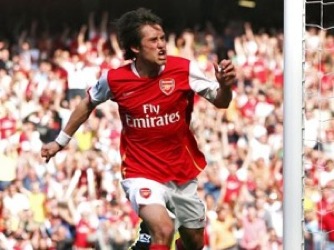Abou Diaby, Eduardo da Silva and Aaron Ramsey: victims of over-aggression, the accepted means of stopping Arsenal for the myriad prosaic sides of the Premier League. No other club has had to contend with such savage treatment, and while the neutrals condone it, or turn a blind eye, it won’t end any time soon. But it’s truthfully a drop in the ocean that is Arsenal’s inherent injury crisis, one that hasn’t needed compound fractures to help it undermine title challenges and define the last few years for the club.
This Saturday, the club faces Blackpool – be thankful it’s not anyone better – with one truly fit centre back, one truly fit centre forward, and without a host of midfielders (Emmanuel Frimpong being the latest long term casualty). Maintaining the fitness of Tomas Rosicky and Johan Djourou – yes, that Tomas Rosicky and that Johan Djourou – is a genuine necessity while the squad is weakened by the absence of so many players and the fitness of players like Fabregas, van Persie, Diaby and Song is questionable. Their fitness could be jeopardised if the players further along in match fitness terms continue to drop and they are called on to do too much too soon.
The whole pattern of a player being rushed back while unfit only to suffer a more serious injury is commonplace at the club, just ask William Gallas. It’s as key a factor in the ongoing injury plague as the tactics of opponents. Quite what has caused it is clearly beyond the grasp of those at the club, so what chance do we have? You have to believe that Wenger’s preference for slight players, the history of buying players with previous injury problems, the hard-ass E******s pitch, the workload demanded of young players who should perhaps be more sheltered and the self-perpetuating nature of injuries (weakening the sufferer going forward as well as increasing the physical burden on those not yet afflicted) are all having an effect.
So if a magic bullet remedy isn’t on the horizon, a more pragmatic approach is the only way forward; and luckily that’s nice and simple: squad size.
The size of the Arsenal squad currently fits well inside the 25-man over-21 cap. While Roberto Mancini struggles to manage his under the new rule’s limitations, Wenger has room to spare and should look to take advantage. A small, young, injury-prone core needs support and protection. The concerns the manager has over stunting a player’s development are false. Competition and a lighter burden are both good for players in the early years of their careers, and the onset of repetitive injuries will do more damage in the short-and-long-term than the presence of more players on the ladder.
Hopefully Sebastian Squillaci is on his way, and he’s exactly the kind of player required. Bringing him in alone only makes the situation at centre back less shallow; there’s room for one more centre back at least and a central midfielder. Three players to help a squad that is already creaking under the weight of its physical susceptibilities. Add to that the situation in goal and there’s plenty that Wenger can still do to prepare this side for the season ahead between now and September. Would failing to do so, if injuries continue to be such a prominent spectre, be responsible, or right for the club?







